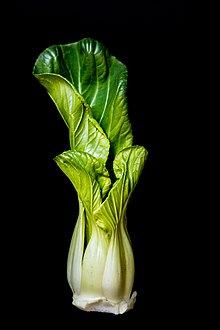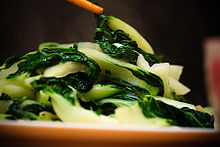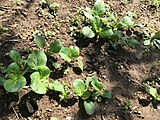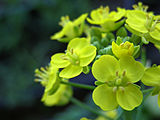Bok choy
| Bok choy | |
|---|---|
 Brassica rapa subsp. chinensis | |
| Species | Brassica rapa |
| Cultivar group | Chinensis |
| Origin | China, 5th century AD[1] |
Bok choy (American English, Canadian English, and Australian English), pak choi (British English, South African English, and Caribbean English) or pok choi is a type of Chinese cabbage (Brassica rapa subsp. chinensis) cultivated as a leaf vegetable to be used as food. Varieties do not form heads and have green leaf blades with lighter bulbous bottoms instead, forming a cluster reminiscent of mustard greens. Its flavor is described as being between spinach and water chestnuts but slightly sweeter, with a mildly peppery undertone. The green leaves have a stronger flavor than the white bulb.[2][3]
Chinensis varieties are popular in southern China, East Asia, and Southeast Asia. Being winter-hardy, they are increasingly grown in Northern Europe.[citation needed] Originally classified as Brassica chinensis by Carl Linnaeus,[citation needed] they are now considered a subspecies of Brassica rapa.They are a member of the family Brassicaceae.
Spelling and naming variations
[edit]| Cooked bok choy | |
|---|---|
 | |
| Chinese name | |
| Chinese | 青菜, 小白菜 |
| Hanyu Pinyin | qīngcài, xiǎobáicài |
| Bopomofo | ㄑㄧㄥ ㄘㄞˋ, ㄒㄧㄠˇ ㄅㄞˊ ㄘㄞˋ |
| Gwoyeu Romatzyh | chingtsay, sheaubairtsay |
| IPA | [tɕʰíŋ.tsʰâɪ], [ɕjàʊ.pǎɪ.tsʰâɪ] |
| Romanization | tsching tsae |
| Cantonese and Southern Min name | |
| Chinese | 白菜 |
| Yale Romanization | baahk choi |
| Jyutping | baak6 coi3 |
| IPA | [pàːk tsʰɔ̄ːy] |
| Hokkien POJ | pe̍h-chhài or pe̍eh-chhài |
| Korean name | |
| Hangul | 청경채 |
| Hanja | 靑莖菜 |
| Revised Romanization | cheonggyeongchae |
| Japanese name | |
| Kanji | 青梗菜 |
| Katakana | チンゲンサイ |
| Romanization | chingensai |
Other than the term "Chinese cabbage", the most widely used name in North America for the chinensis variety is bok choy (Cantonese for "white vegetable") or siu bok choy (Cantonese, for "small white vegetable", as opposed to dai bok choy meaning "big white vegetable", referring to the larger Napa cabbage). It is also sometimes spelled as pak choi, bok choi, and pak choy. In the UK, South Africa, and the Caribbean the term pak choi is used. Less commonly, the names Chinese chard, Chinese mustard, celery mustard, and spoon cabbage are also used.
There are two main types of bok choy, collectively called 小白菜 xiǎo bái cài ("small white vegetable") in Mandarin. One is white bok choy (Chinese: 奶白菜; lit. 'milky white vegetable') with dark green blades and white stalks, which is primarily cultivated in South China, and in Cantonese it is simply called baak choi (Chinese: 白菜; lit. 'white vegetable'; the same characters pronounced bái cǎi by Mandarin speakers are preferably used for Napa cabbage[4]). The other is green bok choy (Chinese: 青白菜; lit. 'green white vegetable'; Chinese: 青菜; lit. 'green vegetable'; Chinese: 上海青; lit. 'Shanghai green'; Chinese: 青梗菜; lit. 'green-stalk vegetable'; Chinese: 小唐菜; lit. 'small Chinese vegetable') with light green stalks, which is more common in East China; the young and tender plants of green bok choy is called baby bok choy (Chinese: 雞毛菜; lit. 'chicken-feather vegetable'), which is less crisp and therefore may become too soft if overcooked.[5][6]
In Australia, the New South Wales Department of Primary Industries has redefined many transcribed names to refer to specific cultivars. They have introduced the word buk choy to refer white bok choy and redefined pak choy to refer to green bok choy.[7][8][9]
Uses
[edit]Cooking
[edit]Bok choy cooks in 2 to 3 minutes by steaming, stir-frying, or simmering in water (8 minutes if steamed whole). The leaves cook faster than the stem. It is often used in similar ways to other leafy vegetables such as spinach and cabbage.[10] It can also be eaten raw.[11] It is commonly used in salads.
Preserving
[edit]Dried bok choy is saltier and sweeter. Pickled bok choy remains edible for months.[12] Immature plants have the sweetest, tenderest stems and leaves.[13]
Nutritional value
[edit]| Nutritional value per 100 g (3.5 oz) | |||||||||||||||||||||||||||||||||||||||||||
|---|---|---|---|---|---|---|---|---|---|---|---|---|---|---|---|---|---|---|---|---|---|---|---|---|---|---|---|---|---|---|---|---|---|---|---|---|---|---|---|---|---|---|---|
| Energy | 54 kJ (13 kcal) | ||||||||||||||||||||||||||||||||||||||||||
2.2 g | |||||||||||||||||||||||||||||||||||||||||||
| Dietary fiber | 1.0 g | ||||||||||||||||||||||||||||||||||||||||||
0.2 g | |||||||||||||||||||||||||||||||||||||||||||
1.5 g | |||||||||||||||||||||||||||||||||||||||||||
| |||||||||||||||||||||||||||||||||||||||||||
| Other constituents | Quantity | ||||||||||||||||||||||||||||||||||||||||||
| Water | 95.3 g | ||||||||||||||||||||||||||||||||||||||||||
| †Percentages estimated using US recommendations for adults,[14] except for potassium, which is estimated based on expert recommendation from the National Academies.[15] | |||||||||||||||||||||||||||||||||||||||||||
The raw vegetable is 95% water, 2% carbohydrates, 1% protein and less than 1% fat. In a 100-gram (3+1⁄2-ounce) reference serving, raw bok choy provides 54 kilojoules (13 food calories) of food energy and is a rich source (20% or more of the Daily Value, DV) of vitamin A (30% DV), vitamin C (54% DV) and vitamin K (44% DV), while providing folate, vitamin B6 and calcium in moderate amounts (10–17% DV).
History
[edit]This section needs expansion. You can help by adding to it. (April 2022) |
Bok choy evolved in China, where it has been cultivated since the 5th century CE.[1]
Gallery
[edit]-
Young bok choy plants in garden
-
Bok choy
-
White bok choy
-
Green bok choy
-
Bok choy plant in side view
-
Bok choy has yellow flowers
-
Bok choy as depicted in art, the Jadeite Cabbage[16]
See also
[edit]References
[edit]- ^ a b Sanderson, Helen; Renfrew, Jane M. (2005). Prance, Ghillean; Nesbitt, Mark (eds.). The Cultural History of Plants. Routledge. p. 115. ISBN 0415927463.
- ^ "What Does Pak Choi Taste Like?". Thrive Cuisine. 2 March 2019. Retrieved 13 December 2021.
- ^ "Genetic Characterization of Brassica rapa chinensis L.,B. rapa parachinensis (L. H. Bailey) Hanelt, and B. oleracea alboglabra (L. H. Bailey) Hanelt Using Simple Sequence Repeat Markers" (PDF). Philippine Journal of Science. December 2009. Retrieved 16 February 2023.
- ^ "Brassica rapa var. glabra in Flora of China". efloras.org. Retrieved 2022-04-28.
- ^ "Ingredient Spotlight: Shanghai Bok Choy". 5 October 2011.
- ^ "Regular vs. Shanghai Baby Bok Choy | Cook's Illustrated".
- ^ "Help is on the way for consumers confused by the wide array of Asian vegetables on sale". 2009-10-22. Archived from the original on 2007-08-20. Retrieved 2011-09-08.
- ^ "Asian vegetable names" (PDF). Archived (PDF) from the original on 2006-10-30.
- ^ Ekman, Jenny (October 2008). "Improving Market Access for Asian Vegetables" (PDF). Rural Industries Research and Development Corporation. Retrieved 2023-12-06.
- ^ "Pak choi". BBC Good Food. Retrieved 2 February 2022.
- ^ Smith, Emma (6 August 2023). "Can You Eat Bok Choy Raw". Leftover Guide. Retrieved 7 August 2023.
- ^ "6 Ways to Store Bok Choy so It Lasts Longer". Homestratosphere. 20 May 2019. Retrieved 20 February 2023.
- ^ "Harvesting Bok Choy Plants: How And When To Pick Bok Choy". Gardening Know How. 29 July 2012. Retrieved 20 February 2023.
- ^ United States Food and Drug Administration (2024). "Daily Value on the Nutrition and Supplement Facts Labels". FDA. Archived from the original on 2024-03-27. Retrieved 2024-03-28.
- ^ National Academies of Sciences, Engineering, and Medicine; Health and Medicine Division; Food and Nutrition Board; Committee to Review the Dietary Reference Intakes for Sodium and Potassium (2019). "Chapter 4: Potassium: Dietary Reference Intakes for Adequacy". In Oria, Maria; Harrison, Meghan; Stallings, Virginia A. (eds.). Dietary Reference Intakes for Sodium and Potassium. The National Academies Collection: Reports funded by National Institutes of Health. Washington, DC: National Academies Press (US). pp. 120–121. doi:10.17226/25353. ISBN 978-0-309-48834-1. PMID 30844154. Retrieved 2024-12-05.
- ^ "National Treasure Diaporama—Qing dynasty Jadeite Cabbage". National Palace Museum. 2017.
External links
[edit] Media related to Brassica rapa subsp. chinensis at Wikimedia Commons
Media related to Brassica rapa subsp. chinensis at Wikimedia Commons







![Bok choy as depicted in art, the Jadeite Cabbage[16]](http://upload.wikimedia.org/wikipedia/commons/thumb/d/de/Jadeite_Cabbage%2C_National_Palace_Museum.jpg/90px-Jadeite_Cabbage%2C_National_Palace_Museum.jpg)